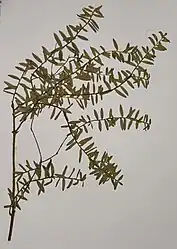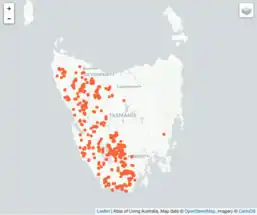| Trochocarpa gunnii | |
|---|---|
 | |
| Scientific classification | |
| Kingdom: | Plantae |
| Clade: | Tracheophytes |
| Clade: | Angiosperms |
| Clade: | Eudicots |
| Clade: | Asterids |
| Order: | Ericales |
| Family: | Ericaceae |
| Genus: | Trochocarpa |
| Species: | T. gunnii |
| Binomial name | |
| Trochocarpa gunnii (Hook.f.) Benth. | |
Trochocarpa gunnii, commonly known as sweet-scented trochocarpa or fragrant purpleberry, is a common rainforest understorey shrub from the plant family Ericaceae (formerly Epacridaceae) endemic to Tasmania.
Description

Trochocarpa gunnii is a densely branched understorey shrub, usually growing to 2-4m tall[1][2] and spreading with twisting branches.[3] Leaves grow alternately along the branches, arranged so that the shoot appears flattened.[4] The leaves are small (6-10mm long) and oval-elliptical to oblong shaped, with a dark green adaxial (upper) surface and a lighter green abaxial (lower) surface.[1] Leaves have 5-7 parallel veins running along the abaxial surface. T. gunnii has small, white, pink or red flowers, and is the only species in this genus with a glabrous corolla.[4] The flowers are sweetly scented and arranged in short spikes near the ends of branches or in the axils of leaves of the previous year’s shoots.[2][3] Flowers can be seen in the summer months of December to March. The fruits of T. gunnii are small purple/blue, sometimes orange, globular drupes, 6-8mm in diameter.[3] The seeds are dispersed by birds.
This species can be confused with Trochocarpa cunninghamii, which is a low growing, scrambling shrub with red flowers, and is more commonly found at high altitudes.[4] The rainforest Archeria species (A. eriocarpa and A. hirtella)[5] also have similar foliage to T. gunnii, however these species only have one vein on the underside of the leaf.


Distribution

Trochocarpa gunnii is endemic to Tasmania and is found in rainforests and sub-alpine areas of the North West, West and South of the state.[3][6] It is sometimes found near quartzite outcrops, and grows well in moist, rocky, well-drained soil in sheltered areas.[3] It is present in thamnic rainforests, which have a well-developed shrub layer and may include native laurel, native plum and horizontal.[7] Locations that T. gunnii occur in include South West of Lake St. Clair, Hampshire Hills,[2] Mt Field,[1] and many more.[6]
Taxonomy
Trochocarpa: Greek trochos means wheel, and carpos means fruit.[8] Gunnii is named after Ronald Campbell Gunn of Launceston[9] (1808-1881) who was a botanist, public servant and politician.[10] This species’ common names are sweet-scented trochocarpa and fragrant purpleberry, due to the sweet odour of its flowers and its purple berries.
Phylogeny
The closest relatives of Trochocarpa gunnii appear to be Monotoca scoparia and Montitega dealbata,[11] both of which occur in Tasmania.[6] M. scoparia is endemic to Australia[12] and is found in many parts of the South East of the country, while M. dealbata is endemic to Tasmania,[13] as T. gunnii is. However, this phylogenetic tree is debated at the genus level and is inconclusive at this specificity.
References
- 1 2 3 Jordan, Greg. "Species Information: Trochocarpa gunnii".
- 1 2 3 Bentham, George; Mueller, Ferdinand von (1869). Flora australiensis: a description of the plants of the Australian territory. Vol. 4. London: L. Reeve and co.
- 1 2 3 4 5 "Communities". www.understorey-network.org.au. Retrieved 2023-03-27.
- 1 2 3 Jordan, Greg. "Key to Tasmanian Dicots: Trochocarpa gunnii".
- ↑ "Key to Tasmanian Dicots". www.utas.edu.au. Retrieved 2023-03-27.
- 1 2 3 Australia, Atlas of Living. "Species: Trochocarpa gunnii". bie.ala.org.au. Retrieved 2023-03-27.
- ↑ "Forestry | Department of State Growth". www.stategrowth.tas.gov.au. Retrieved 2023-03-27.
- ↑ Wapstra, Mark (2010). Tasmanian plant names unravelled. Fullers Bookshop. ISBN 978-0-9804720-2-8. OCLC 681305362.
- ↑ "Acacia". www.utas.edu.au. Retrieved 2023-03-27.
- ↑ Burns, T. E.; Skemp, J. R., "Gunn, Ronald Campbell (1808–1881)", Australian Dictionary of Biography, Canberra: National Centre of Biography, Australian National University, retrieved 2023-03-27
- ↑ Johnson, Karen A.; Holland, Barbara R.; Heslewood, Margaret M.; Crayn, Darren M. (2012-01-01). "Supermatrices, supertrees and serendipitous scaffolding: Inferring a well-resolved, genus-level phylogeny of Styphelioideae (Ericaceae) despite missing data". Molecular Phylogenetics and Evolution. 62 (1): 146–158. doi:10.1016/j.ympev.2011.09.011. ISSN 1055-7903.
- ↑ "Flora of Victoria". vicflora.rbg.vic.gov.au. Retrieved 2023-03-27.
- ↑ "Key to Tasmanian Dicots". www.utas.edu.au. Retrieved 2023-03-27.